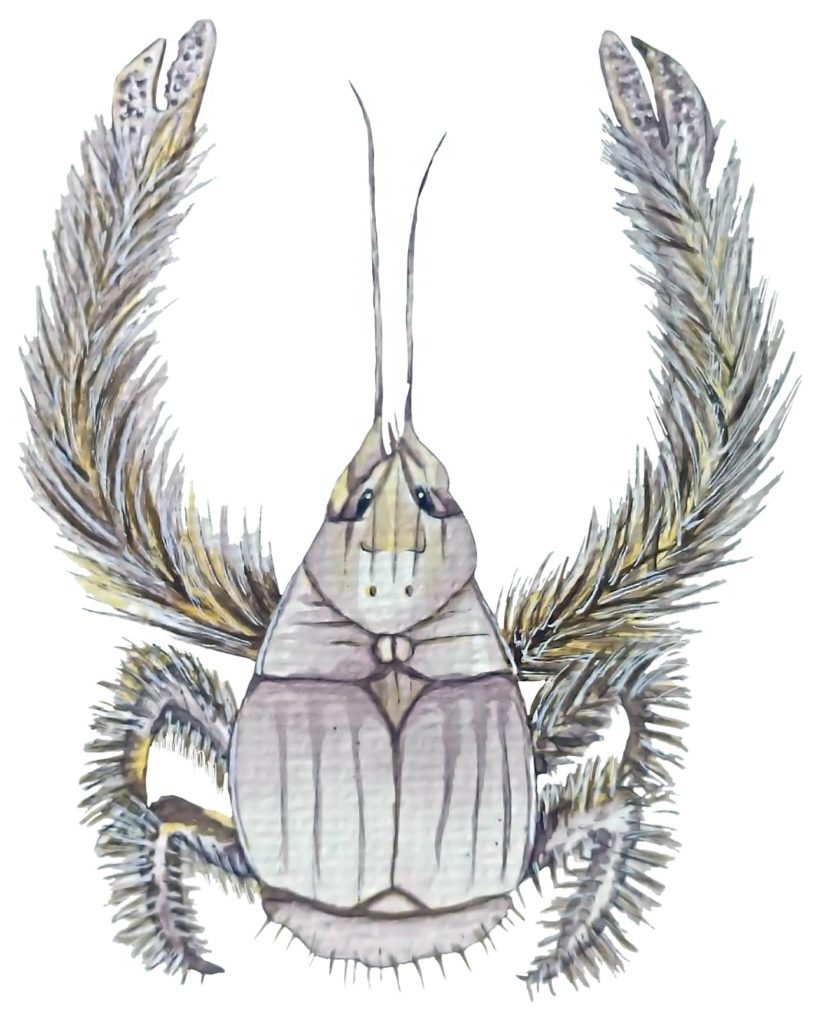By Jim Knox

There is a beast of legend which haunts the “Roof of the World,” the highest peaks of the Himalayas. Roaming the inaccessible heights, it is the embodiment of all things elusive and wild—inspiring wonder of the unknown. A creature of cryptozoology or hidden zoology, it lives as a myth to most but as an actual creature to believers. It is known simply as, the Yeti.
It is often said that life imitates art. Nature has its own version of this expression when zoology imitates cryptozoology. Enter, the Yeti Crab. The Yeti Crab, Kiwa hirsuta, is a fascinating, and until recently, unknown species. Discovered in the 21st century, in the depths of the Pacific-Antarctic Ridge South of Easter Island, it dwells in one of the planet’s most inhospitable and poorly known habitats.
Discovered by researchers from the Monterey Bay Aquarium Research Institute (MBARI) aboard the record-setting deep sea submersible, Alvin during an expedition to study deep sea hydrothermal vent habitats, it was just one of many new species to emerge from this scientific initiative.
Unlike its namesake alleged to roam habitat thousands of feet above sea level, the Yeti Crab dwells in habitat thousands of feet below sea level—at least 7,200 feet below sea level to be exact! And it is this habitat that provides a unique home for equally unique life forms. Massive clams, a foot across, giant tube worms approaching ten feet in length, and stilt-legged blind shrimp are among the diverse fauna inhabiting hydrothermal vent regions along the ocean floor. With temperatures exceeding 700 degrees Fahrenheit due to the presence of lava just below the seafloor, and inorganic and organic compounds like copper and sulfur spewing from hydrothermal vents known as “smokers”, these rare habitats are completely devoid of light, superheated, and brimming with nutrients.
 While much remains unknown about the Yeti Crab’s ecological role within these hydrothermal vent communities, it is known to be a successful scavenger, and perhaps, even a “farmer.” This ghostly 6-inch-long beast with a tear-drop carapace and long, thick front claws is unusual in appearance. Yet the beast’s most conspicuous feature is the long, thick “hair” covering its claws and legs—evoking reference to its Himalayan namesake. Its scientific name, “hirsuta,” refers to this “hair” which is actually a profuse covering of flexible, spine-like projections known as setae. These setae function as tactile and chemo sensors, enabling the blind crabs to detect food and locate mates in their lightless deep-sea realm. What’s more, research has revealed that colonies of specialized filamentous bacteria reside within the crab’s setae, leading scientists to believe that these remarkably adapted crustaceans “farm” the bacteria as a food source grown in these sulfur-rich waters. As the bacteria harvest organic and inorganic compounds from the nutrient-rich waters, the crabs in turn harvest the bacteria.
While much remains unknown about the Yeti Crab’s ecological role within these hydrothermal vent communities, it is known to be a successful scavenger, and perhaps, even a “farmer.” This ghostly 6-inch-long beast with a tear-drop carapace and long, thick front claws is unusual in appearance. Yet the beast’s most conspicuous feature is the long, thick “hair” covering its claws and legs—evoking reference to its Himalayan namesake. Its scientific name, “hirsuta,” refers to this “hair” which is actually a profuse covering of flexible, spine-like projections known as setae. These setae function as tactile and chemo sensors, enabling the blind crabs to detect food and locate mates in their lightless deep-sea realm. What’s more, research has revealed that colonies of specialized filamentous bacteria reside within the crab’s setae, leading scientists to believe that these remarkably adapted crustaceans “farm” the bacteria as a food source grown in these sulfur-rich waters. As the bacteria harvest organic and inorganic compounds from the nutrient-rich waters, the crabs in turn harvest the bacteria.
 Connected by myth to more than one culture, this singular species—the sole-known member of its genus, is also named after the Polynesian Goddess of Shellfish, Kiwa and the Māori Guardian of the Sea of the same name. Known as a decapod “ten-footed” crustacean, the Yeti Crab is unique among this order of 15,000 or so species which includes lobsters, true crabs, hermit crabs and shrimp. With the known facts of the Yeti Crab being few, it is the unknown swirling around this beast that draws us in.
Connected by myth to more than one culture, this singular species—the sole-known member of its genus, is also named after the Polynesian Goddess of Shellfish, Kiwa and the Māori Guardian of the Sea of the same name. Known as a decapod “ten-footed” crustacean, the Yeti Crab is unique among this order of 15,000 or so species which includes lobsters, true crabs, hermit crabs and shrimp. With the known facts of the Yeti Crab being few, it is the unknown swirling around this beast that draws us in.
Given its extreme deep-water habitat requirements of approximately 7,000 feet, only a handful of the world’s submersibles can even record its presence. Specifically, while seemingly plentiful among certain hydrothermal vent communities, it appears absent from others. This “feast or famine” presence leads researchers to believe Yeti Crabs have a limited or local range. The crab’s observed connection to hydrothermal “smoker” vent waters coupled with the location of most of the Pacific’s known hydrothermal vents have led to a projected range encompassing the known “smoker” communities. While not yet confirmed, the crab is believed to be omnivorous, (like nearly all the world’s known crabs) hunting, scavenging, and eating algae and other plant matter. Like the majority of the planet’s newly discovered species, the Yeti Crab’s recorded natural history could fit into a thimble. From sensory capabilities, to diet, predators, range, and reproduction, we are still connecting the dots to formulate an accurate image of this mysterious beast.
Inspired by a legend and living in a realm humans can scarcely penetrate, this creature functions beyond our sight and beyond our reckoning. Discovered through exploration, and described by science, we can remain confident that the Yeti Crab—like its fellow wild creatures, will reveal its secrets on its own terms, and in its own time.




